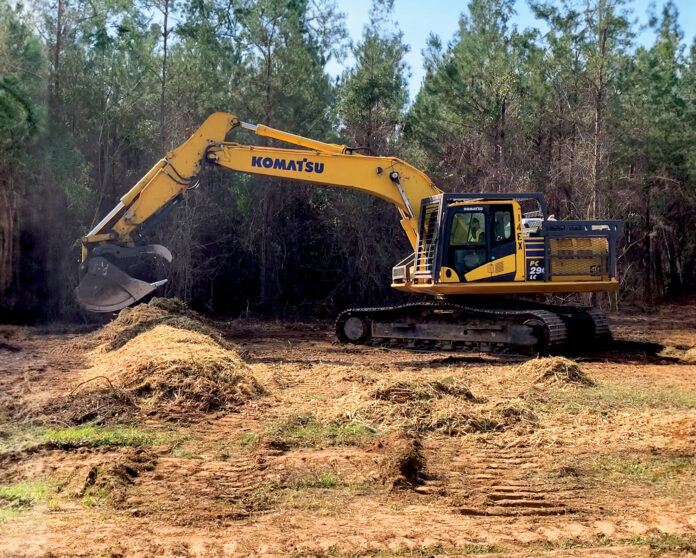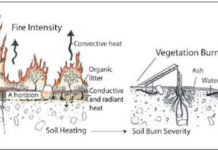Alabama Power Company in Birmingham, Alabama, USA, is taking the use of vegetative debris from land clearing — trees, bushes and other woody refuse — to new heights by using natural mulch berms instead of plastic silt fencing (Figure 1).
The company has a newly approved best management practice (BMP): Repurposing leftover mulch from land-clearing activities during construction to create natural berms on rights of way (ROW) to remove sediment from stormwater. This approach was used to help prevent sedimentation along a 5-mile path (8.05-km) of rights of way construction in Baldwin County, Alabama.
Alternative to Silt Fence
Buying and installing geotextile fabric silt fencing for large construction projects is a significant expense. Taking silt fences out of the construction equation and eliminating the need for regular maintenance and proper disposal, reduces waste, protects air and water quality and saves on costs.
Research conducted by Alabama Power in partnerships with Auburn University included tests to determine if berms created with natural, vegetative material gathered at construction sites could effectively reduce sediment loss.
In addition to evaluating the stormwater filtering benefits, the environmental benefits identified included the reduction or elimination of the need to move material to landfills, which reduces traffic and vehicle emissions while decreasing landfill waste.
The potential to save money and reduce environmental impact by using mulch on-site for erosion and sediment control was a viable option to study because one mile (1.61 km) of transmission line construction can produce about two million pounds (907 mt) of vegetative material.
From March 2023 through the first quarter 2024, Alabama Power enjoyed savings of approximately $78,000 USD per mile of construction by using natural mulch berms during the building of transmission line ROW at the industrial site in Baldwin County.
The company enjoyed a cost savings by using a natural mulch berm instead of silt fencing. The Environmental Affairs team estimated the cost of installing mulch berm at $3 USD per square foot, compared to $5 USD per square foot for silt fencing. While there is little to no maintenance costs for maintaining mulch berm, plastic fencing is fragile and easily damaged and requires maintenance at $15 USD per square foot.
Alabama Power estimates that use of silt fencing creates three pounds per square foot of waste compared to zero landfill waste from natural berms. An additional cost savings is the elimination of transportation site debris to a landfill.
The Auburn University research showed that natural berms, when installed correctly, were better at filtering stormwater and retaining sediment on-site than the silt fencing, so that any runoff was significantly cleaner compared to what passed through traditional fencing.
The Auburn University study found 98% sediment capture by the berms. There was an 83.9% average total suspended solids reduction downstream. Turbidity downstream was reduced by an average of 78.5%. Silt fences have an average discharge turbidity of approximately 1000 NTU; the slash mulch berms resulted in an effluent turbidity of 631 NTU.
Berms also produced less impact to the natural landscape, and fewer employees were needed on-site for installation, maintenance and removal of silt fence.
After research proved the concept, approval for broader use of berms was sought. Approval by the Alabama Department of Environmental Management was received in March 2023.

Site Work Proves Effectiveness
The need to clear the Baldwin County site was a perfect proving ground. It is not unusual to burn tree stumps and vegetation when land is cleared. If burning is not allowed, trucks must haul the vegetation to a landfill for disposal, which can be costly.
Natural mulch berms are a mix of trees and vegetation removed during “clearing and grubbing” operations. Bulldozers and other equipment was used to push up woody debris from the ROW, approximately 300 feet wide (91.4 m), 7,400 meters long (7.4 km). Afterward, the company built two transmission lines to serve the site.
Wood chipping and mulching was done on-site (Figure 2). With berms left in place, sediment will fill them in over time. The berms eventually break down and become part of the landscape.
Because trucks weren’t required to go to a landfill for mulch disposal, Alabama Power also reduced CO2 emissions. At a typical transmission construction site, as many as 100 truckloads of material may be removed daily and transported about 30 miles (48.3 km) to a landfill. Eliminating transportation of material translates to more than 291 metric tons of avoided CO2 emissions, not to mention emissions avoided because material was not burned.
An additional benefit is that mulch berms are more aesthetically pleasing during and after construction.
The ROW construction — time-consuming and expensive work — was Alabama Power’s first step in helping to develop a future plant site.
To prepare for the use of mulch berms, several employees within the company’s Environmental Affairs group performed behind-the-scenes research for nearly three years. The findings cleared the way for Alabama Power to implement this best management practice of substituting mulch berms for silt fencing during construction projects.
Looking to the Future
Alabama Power’s construction activities at the Baldwin County site are complete. The company expects to use mulch berms on multiple projects throughout the state and foresees many potential uses.
About the Expert
Donna Cope is a communications specialist at Alabama Power, where she has worked for 33 years.












